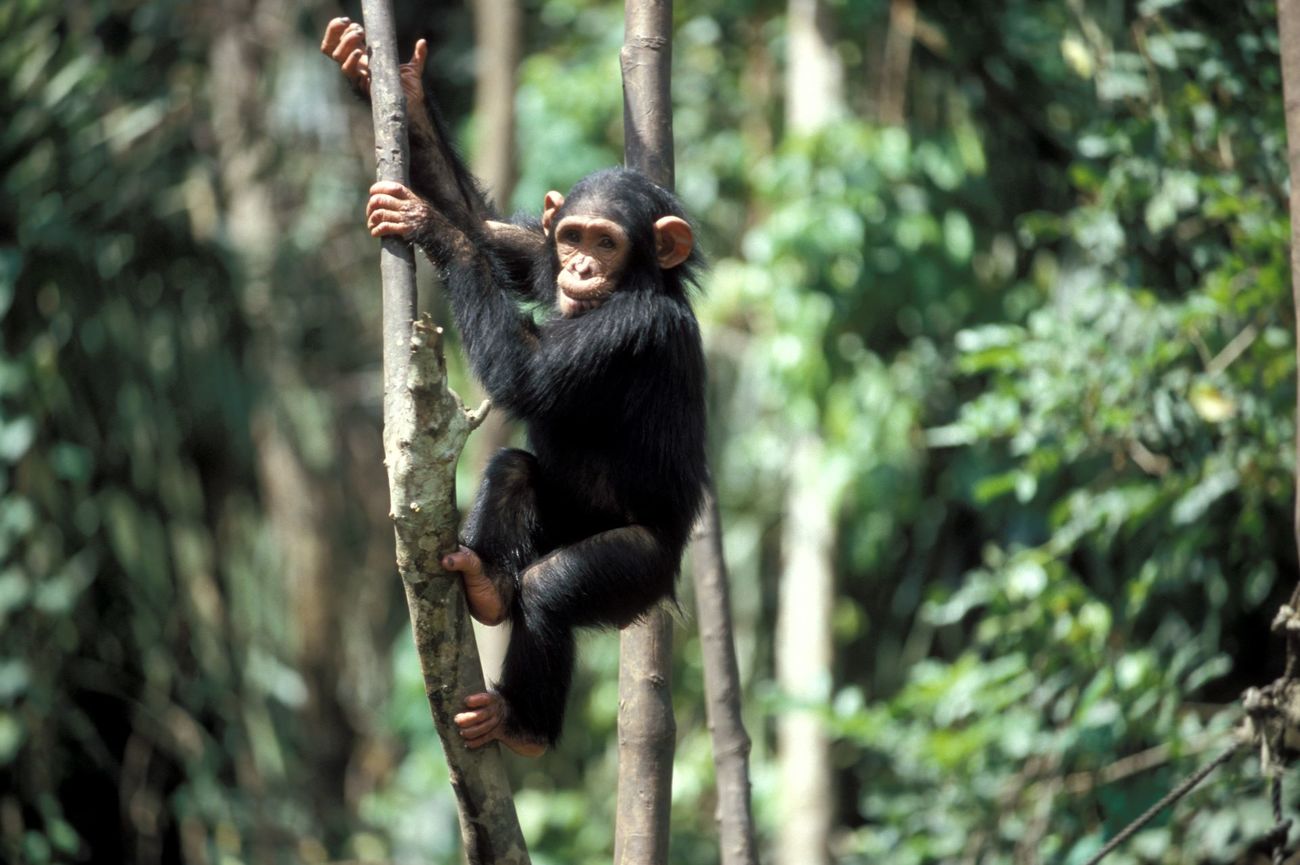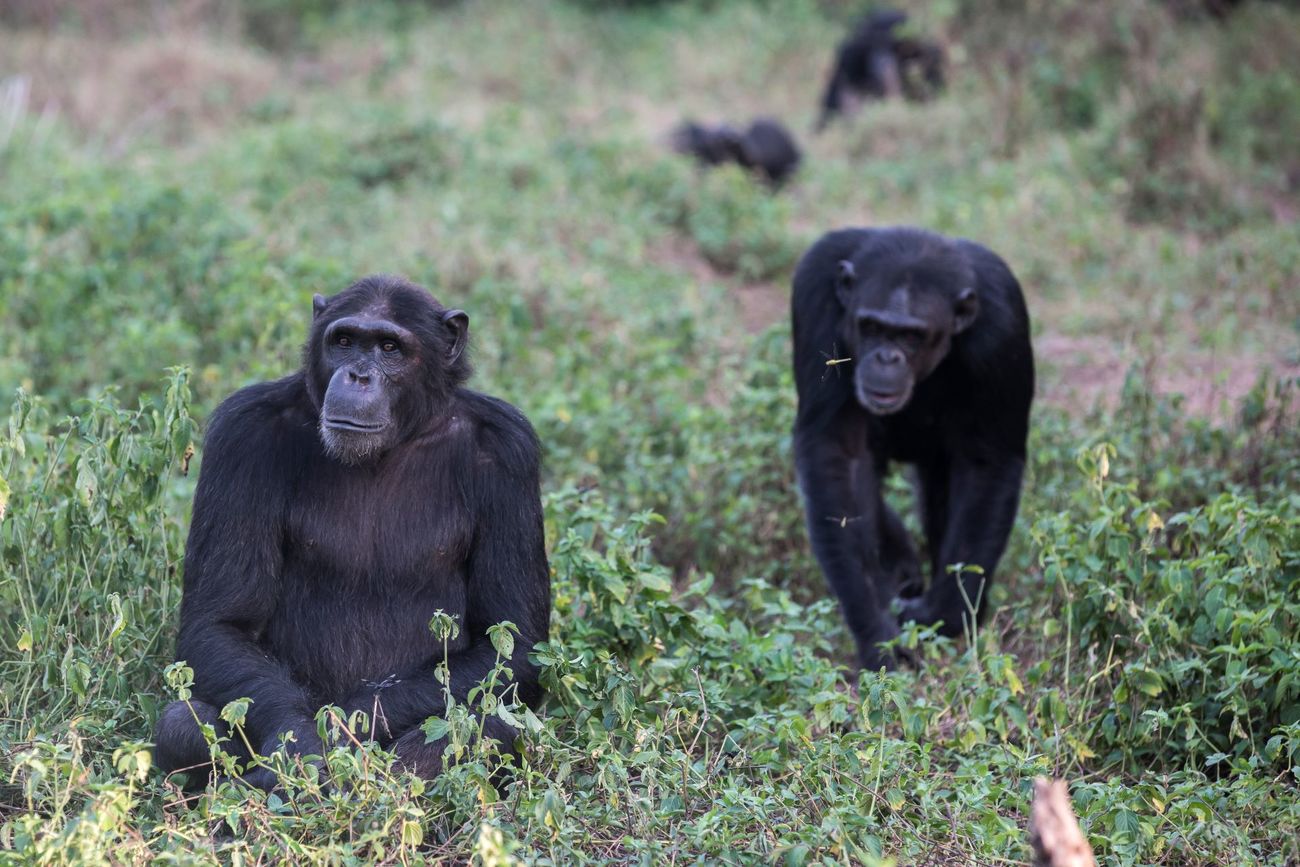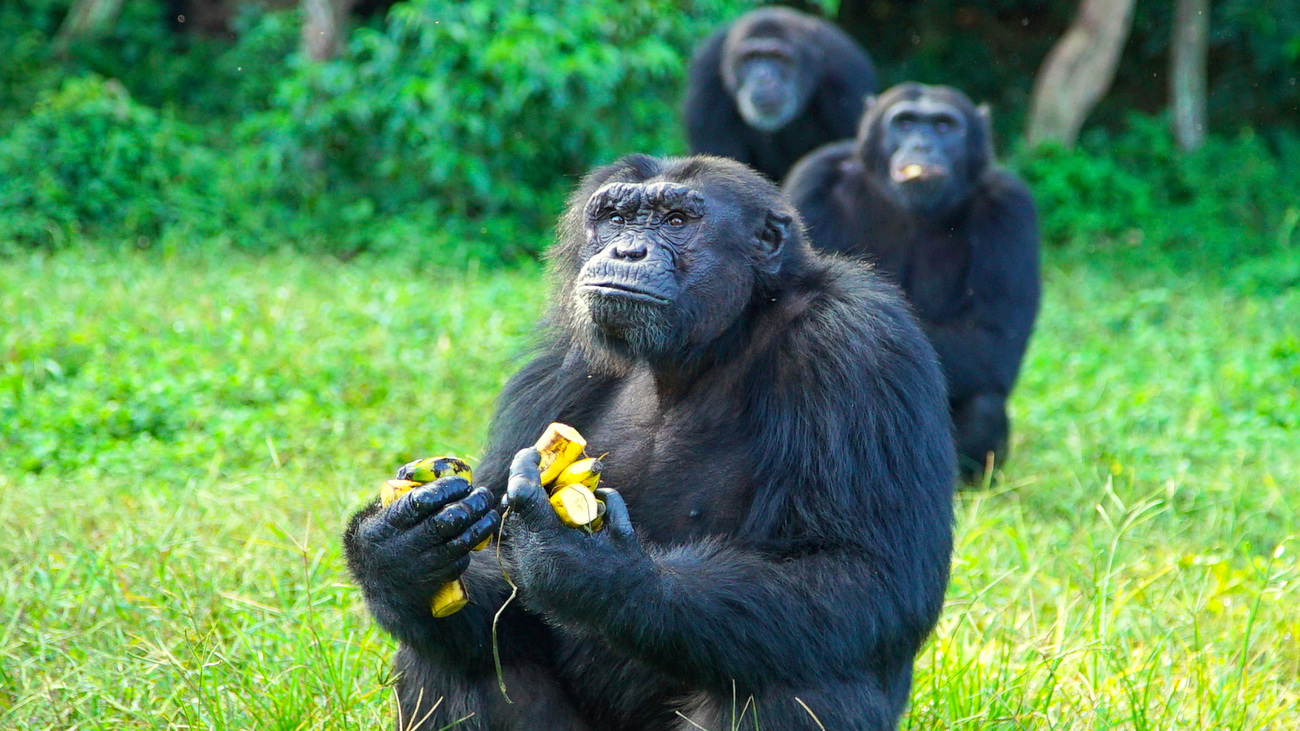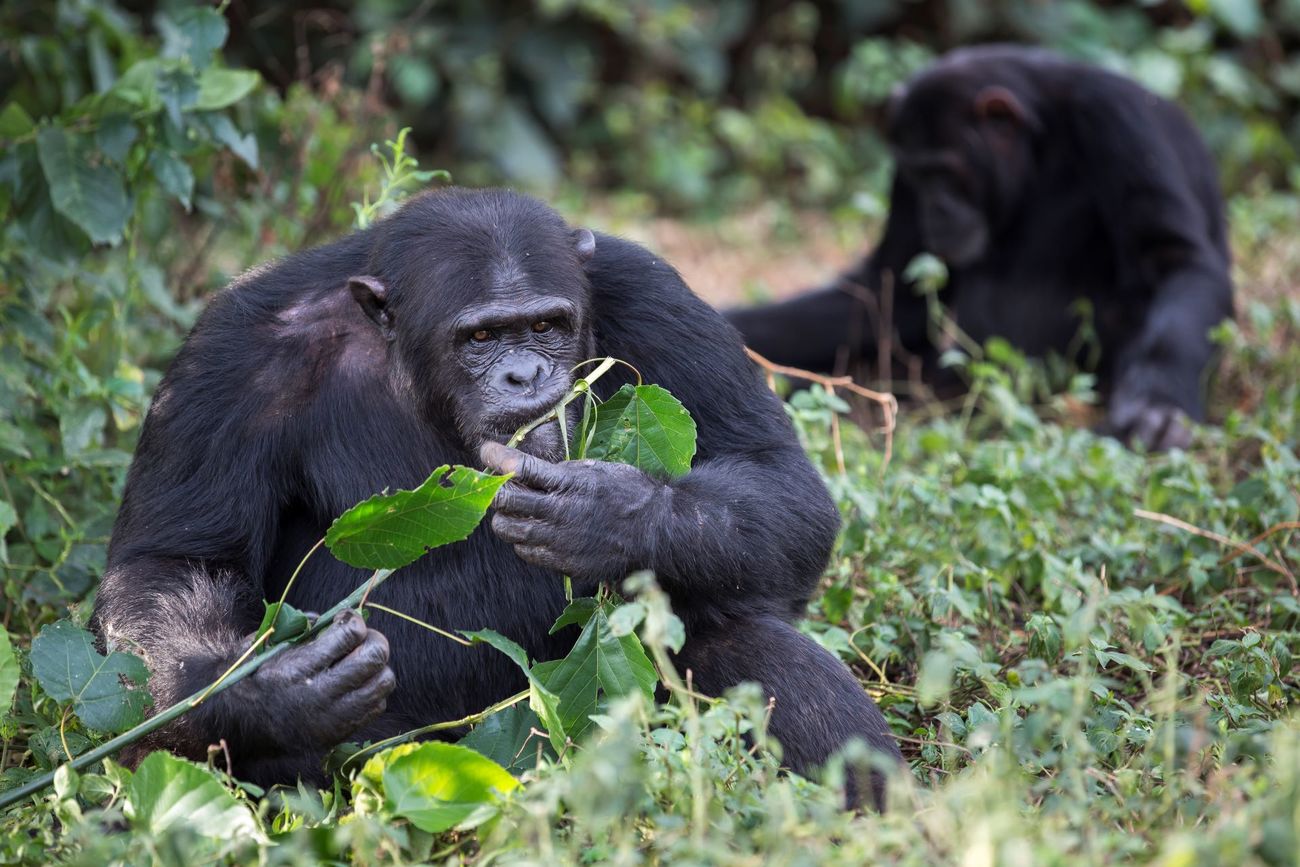Chimpanzees
Chimpanzees, also known as just chimps, are highly social animals that live in groups with dozens of other chimpanzees, known as communities. These communities are led by an alpha male, who is supported by a group of other males. Belonging to the great ape species, chimpanzees are very closely related to humans, sharing 98.7% of our DNA.
Chimpanzees’ bodies are covered in a coat of dark brown or black hair and usually have a short white beard on their chins. Their skin colour is mostly white underneath their fur, although their faces, hands, and feet are all typically black. Younger chimps usually have pinker or whiter faces, which darken when they become adults. As they age, chimpanzees’ foreheads tend to go bald, while their fur often becomes more grey.
With their long arms and short legs, chimpanzees normally walk on all fours in a behaviour known as knuckle-walking, though they can also stand and walk upright. They’re particularly agile at climbing trees and swinging from branch to branch. Adult chimpanzees can range from around four to five feet tall, weighing anywhere from 70 to 130 pounds.
Chimps are known for their intelligence and remarkable problem-solving abilities. Researchers have observed chimpanzees successfully using tools to help them in their day-to-day lives, such as using sticks to pull insects out of the ground or using rocks to crack open nuts.
Within their communities, chimpanzees engage in complex social interactions, forming strong bonds through social behaviours such as grooming and cleaning one another. Chimpanzees communicate with one another using various vocalisations, facial expressions, and body postures. This communication system helps them to share information, establish social hierarchies, and resolve conflicts that arise within the communities. Chimpanzees have also been observed to exhibit emotional expressions such as laughter and gestures of reassurance, which contribute to their social cohesion.
Chimpanzees play a vital role in maintaining the balance of their forest habitats. With a diet consisting mainly of fruits, leaves, nuts, insects, as well as occasionally meat and eggs, their feeding activities help to disperse seeds around the ecosystem, contributing to the growth and regeneration of plant species. Their movements and foraging behaviours also help influence the distribution and diversity of other animal species within their ecosystems.
Dr. Jane Goodall is one of the world’s leading ethologists, famous for studying chimpanzees. Her work has highlighted the urgent need to protect chimpanzees from extinction, while also taking into consideration the needs of the local people as well as the environment.
In order to improve conservation efforts to protect this endangered species, it’s important that we educate ourselves more on the subject. So, to better understand these remarkable creatures, let’s explore some interesting and surprising chimpanzee facts.
What is a chimpanzee’s scientific name?
The scientific name for chimpanzees is Pan troglodytes.
Are chimpanzees endangered?
Unfortunately, chimpanzees are classified by the IUCN Red List of Threatened Species as endangered. Adult chimpanzee populations are continually decreasing, having fallen significantly since the 1980s.
Where do chimpanzees live?
Chimpanzees have the widest geographic distribution of any great ape species, spanning more than 2.6 million square kilometres. The chimpanzee habitat is typically found within tropical rainforests, although they do also live in woodlands and grasslands around West and Central Africa.
You’ll often find chimps up trees, either sleeping in nests of leaves or eating.
Threats
As humans encroach further and further into the natural habitats of chimpanzees, they’re taking away key components to the chimpanzees’ survival. Deforestation, meat hunting, the exotic pet trade, and disease are all major threats to the endangered species. Since female chimpanzees typically give birth at a relatively slow rate of once every five years, more needs to be done to prevent the shrinking of the chimpanzee population.

Habitat loss
Deforestation is a major cause of habitat loss for chimpanzees, as trees provide an important source of food and shelter. One of the primary reasons for deforestation across Africa is due to humans replacing forests with farmland, as well as logging, mining, oil extraction, and the building of infrastructure. This is a particular problem in West Africa, where it’s estimated that more than 80% of the original forest had already been lost by the early 2000s. With the human population continuing to rise rapidly, the problem is expected to grow along with it.
As chimpanzees continue to lose their habitat and consequently their food supply, they’re forced to seek resources elsewhere. Many come to the local homes of humans to find whatever food they can. Most of the time, they’ll take fruit or any other easily accessible food. But on some occasions, the chimps have taken and killed small children. Humans retaliate by killing the chimps to protect their families, leading to a steeper decline in the chimpanzee population.
Hunting
Although the killing or capture of chimpanzees is illegal, poaching remains a huge threat to chimpanzees. The ape species are often hunted as a source of bushmeat.
Beyond the attacks that chimpanzees face through human conflict, chimpanzees can often be targeted for bushmeat because they provide more meat than other smaller animals. It’s especially an issue around logging camps and mining sites, where bushmeat is a more accessible source of food for people. Chimps are usually hunted by humans using either guns or snares to trap them.
When chimpanzees are hunted for meat, their infants are often taken to be kept as exotic pets or illegally trafficked since they are too small to provide enough meat to make them worth killing. It’s estimated that for every infant chimp that’s in a sanctuary, between four to nine adult chimps were likely killed.
However, when you consider that not all of the infants will make it to a sanctuary—because they may have been trafficked as exotic pets or died in transit—it appears that the statistic may actually be a lot higher. Around one in five infants will make it to a sanctuary, meaning that in reality, for every infant that does make it, it’s possible that 25 adult chimpanzees or more were killed or taken.
Disease
As chimpanzees and humans are so closely related, diseases are able to spread from humans to chimpanzees and vice versa. When humans eat bushmeat that comes from a chimp, they’re susceptible to picking up any diseases that it may have been carrying.
For instance, HIV is a disease that had origins in the ape species, and it’s believed that humans may have picked it up through hunting practices. Evidence suggests that the virus likely spread from chimpanzees to humans in Kinshasa, Democratic Republic of Congo, in the 1920s.
But the spread of disease isn’t only a risk for humans. In fact, research has found that the Ebola virus has wiped out a huge number of great apes, affecting around 14% of their total area of distribution.
It doesn’t stop at Ebola. Chimpanzees are susceptible to more than 140 human diseases, including deadly respiratory diseases that travel through the populations.
FAQs
What do chimpanzees eat?
Chimpanzees are omnivores. A chimpanzee’s diet is made up primarily of fruits and plants, though they also consume insects, nuts, eggs, and more. Chimps also eat meat, including smaller monkeys, antelopes, and tortoises.
How many chimpanzees are left in the world?
It’s estimated that there are between 170,000 and 300,000 chimpanzees living in the wild. However, as an endangered species, this number is continually declining.
According to Project Chimps, there are around 2,000 chimps in the US, either in captivity or in sanctuaries.
How much does a chimpanzee weigh?
A chimpanzee weighs anywhere between 32 to 60 kilograms, which is the equivalent of 70 to 130 pounds. Males tend to be larger and weigh more than female chimps.

How big are chimpanzees?
Although chimpanzees often walk on all fours in a movement known as knuckle-walking, when they stand up, they are usually anywhere from 1 to 1.7 metres tall, which is the equivalent of 3 to 3.5 feet.
Why are chimpanzees endangered?
Chimpanzees are endangered due to several threats, including habitat loss, hunting, and disease.
Their loss of habitat is caused by deforestation, which occurs due to human farming and agricultural processes, as well as logging, mining, oil extraction, and building new infrastructure.
Hunting threatens the survival of chimpanzees, as the animal is illegally killed and sold as bushmeat for human consumption. They’re also often killed as a result of resorting to foraging in the homes of humans for food, because their habitat and sources of food are slowly disappearing. Even when they’re not killed during hunting practices, they can sometimes be taken and trafficked in the illegal exotic pet trade.
As chimpanzees are so closely related to humans, they’re susceptible to picking up human diseases. Ebola has had and continues to have a devastating effect on chimpanzee populations, while HIV and other deadly respiratory diseases are also known to spread throughout the species.
How long do chimpanzees live?
The average lifespan of a chimpanzee is around 45 years in the wild. Female chimpanzees reach reproductive age at 13 years old, while males are generally considered to reach adulthood at 15.
What sound does a chimpanzee make?
Chimpanzees usually make grunting, hoo-ing, and barking sounds or noises. Each type of sound is used to convey different meanings.
A grunt is usually linked in some way to food, though panted grunts can often indicate a type of greeting. A hoo is usually in response to a type of threat.
A study from Taï National Park in Africa’s Ivory Coast found that chimps can combine 12 sounds to form 390 ‘words’ or ‘phrases’, each with their own unique meaning, in a kind of chimpanzee language.

How strong are chimpanzees?
Chimpanzees are around 1.5 times stronger than humans.
This is mainly due to chimpanzees having a higher proportion of fast-twitch muscle fibres, which play a role in producing powerful and rapid movements. Humans, on the other hand, have more slow-twitch muscle fibres, which tend to favour endurance over strength. Chimp muscle fibres also tend to be longer than humans’.
Chimps were previously thought to be between four to eight times stronger than humans, but that has been proven to be a myth. The updated knowledge on the strength of chimpanzees comes from studies that compare chimpanzees and humans in pulling and jumping tasks.
How are chimpanzees affected by climate change?
Chimpanzees are already experiencing the effects of climate change and will struggle to adapt to survive as it continues. One effect of climate change is the changing rainfall patterns that are altering lowland forest and savannah ecosystems in Central Africa. Severe droughts are resulting in the loss of vegetation, removing another already diminishing source of food for the ape species.
Chimpanzees are also sensitive to changes in temperature. They survive best in areas where the temperature remains consistent. As global warming predictions indicate more volatile changes in both temperature and rainfall, chimpanzee populations are likely to suffer.
As the climate changes, ecosystems change with it, further affecting the habitats of chimpanzees. Where chimpanzees would have been able to migrate to more hospitable areas, they’re prevented by the expansion of human-occupied urban areas.
Another study has found more subtle ways that chimpanzees are being affected by climate change and their proximity to humans. When living in areas nearby to humans and away from forests or their natural habitat, chimpanzees showed an 88% decline in the number of natural behaviours exhibited.
Our work
IFAW works tirelessly to protect chimpanzees.
During the COVID-19 pandemic, we supported the Ngamba Island Chimpanzee Sanctuary, located on Ngamba Island off the coast of Uganda. This sanctuary is dedicated to rehabilitating orphaned chimpanzees that have been rescued by the Uganda Wildlife Authority.
IFAW has also supported the Jane Goodall Institute in the rescue of a chimpanzee from Angola. In addition, we have helped the Chimpanzee Conservation Center in Guinea, West Africa, to install solar power in their rehabilitation enclosure.

How can you help?
Chimpanzees face threats of habitat loss, hunting, and disease. IFAW is working to protect them.